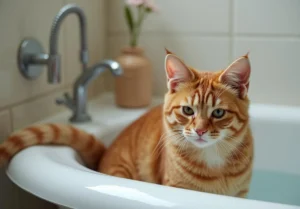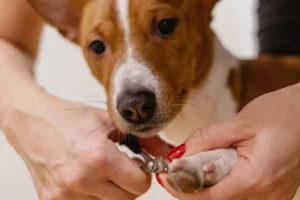Cats scratching bathtubs can be a frustrating experience for many pet owners. Understanding why cats exhibit this behavior can help you address the issue effectively. So, why do cats scratch bathtubs?
Cats scratch bathtubs for a variety of reasons, ranging from territorial marking to nail maintenance. Providing alternative scratching surfaces and addressing any underlying issues can help deter this behavior. Understanding the reasons behind your cat’s bathtub scratching can help you find the right solutions to prevent further damage.
Territorial Behavior
Cats scratching bathtubs is often a display of territorial behavior. Your feline friend is marking its territory and asserting dominance in its environment. Just like how a dog might bark or growl to show ownership, cats use scratching as a way to communicate to other animals that this space is theirs. So, if you notice your cat going to town on your bathtub, it’s likely just trying to make a statement to other pets in the house or to any potential intruders in the area.
Moreover, scratching also helps cats stretch their muscles and relieve stress. By leaving visual and scent markers on the bathtub, they are creating a sense of security for themselves, reducing anxiety levels, and essentially claiming the space as their own. If you want to redirect this behavior, provide alternative scratching posts in areas where your cat likes to scratch. This can help fulfill their need to mark territory while protecting your bathtub from further damage.
Nail Maintenance
Apart from territorial reasons, cats also scratch bathtubs for nail maintenance. Scratching helps trim their nails naturally, removing the outer sheath of the claws and keeping them healthy. Cats have a strong instinct to scratch to keep their nails sharp and in top condition for hunting or self-defense. Providing appropriate scratching posts with different textures can help redirect this behavior from your bathtub to a designated area where they can satisfy their scratching needs without damaging your furniture.
Additionally, trimming your cat’s nails regularly can also reduce the frequency of them scratching the bathtub. Long nails are more likely to get caught on surfaces, making it uncomfortable for the cat and leading to more scratching. By keeping their nails trimmed, you can help prevent them from seeking out rough surfaces like your bathtub. Remember to use proper nail clippers designed for cats and reward your furry companion with treats for a positive experience.
Stress and Anxiety
Cats scratching bathtubs can often be a sign of stress and anxiety. Just like humans, cats can exhibit destructive behaviors when they are feeling overwhelmed or anxious. It could be triggered by changes in their environment, such as a recent move, new pets in the household, or even loud noises. To help mitigate your cat’s stress and reduce the likelihood of bathtub scratching, creating a calming environment is key. Providing hiding spots, vertical space like cat trees, and a quiet area for your feline friend to retreat to can go a long way in reducing their anxiety levels.
Environmental Enrichment
In addition to addressing stress and anxiety, environmental enrichment plays a crucial role in preventing boredom and reducing bathtub scratching. Make sure to provide your cat with plenty of toys to keep them mentally stimulated, scratching posts to satisfy their natural urge to scratch, and engage in interactive play sessions to keep them active and entertained. By enriching your cat’s environment, you can help curb destructive behaviors like scratching and promote their overall well-being.
Helpful Tips for Environmental Enrichment:
- Rotate Toys: Keep your cat’s toys interesting by rotating them regularly to prevent boredom.
- Catnip Fun: Sprinkle some catnip on scratching posts to attract your cat to the appropriate scratching areas.
- Interactive Play: Schedule daily play sessions with your cat using interactive toys to keep them engaged and mentally stimulated.
- Window Perches: Install window perches so your cat can watch the world outside, which can be a great source of mental stimulation.
By incorporating these environmental enrichment strategies into your cat’s daily routine, you can provide them with a stimulating and fulfilling environment that reduces the likelihood of bathtub scratching.
Consistency in Training
To address why cats scratch bathtubs, consistency in training is crucial. Cats are creatures of habit, so establishing a routine is key to discouraging this behavior. Ensure your cat has appropriate scratching posts and regularly redirect them to these designated areas. Reinforce positive behavior by rewarding your cat when they use the scratching post instead of the bathtub. Consistency is key; if you let them scratch the bathtub sometimes and not others, they will be confused. Remember, patience and persistence pay off in training your cat to break the habit of scratching the bathtub.
Consulting a Vet
If your cat’s scratching behavior persists despite consistent training efforts, it may be time to consult a veterinarian. Excessive scratching could be a sign of an underlying medical issue such as skin allergies, parasites, or even behavioral problems. A vet can help rule out any medical conditions that may be causing your cat to scratch the bathtub. Don’t delay seeking professional help if you suspect something more than just normal scratching behavior. Your vet can provide guidance on how to address the issue effectively and ensure your cat’s overall well-being. Remember, your cat’s health is a top priority, so consult a vet if needed.
Additional Unique Insight: Regular grooming can also help reduce scratching behavior by keeping your cat’s nails trimmed and preventing them from feeling the need to scratch excessively. By maintaining their nails, you can help minimize their desire to scratch on hard surfaces like bathtubs.
Tips for Prevention
If your cat has a habit of scratching your bathtub and you’re tired of replacing bath mats, consider these practical steps to deter this behavior. First, provide your feline friend with a designated scratching post or pad near the bathtub. Cats need to scratch to maintain their claws, so offering an appropriate alternative can redirect their scratching instincts. Additionally, try using a double-sided tape on the edges of the bathtub as most cats dislike the sticky texture. You can also sprinkle some citrus-scented or lavender oil around the bathtub as cats generally dislike these smells. Remember to regularly trim your cat’s nails to minimize damage from scratching. Consistency is key when implementing these prevention tactics, so be patient and persistent in redirecting your cat’s behavior.
Fun Facts About Cat Behavior
Did you know that cats scratch not only to sharpen their claws but also to mark their territory? Scratching spreads scent from glands in a cat’s paws, leaving a subtle “calling card” for other cats to detect. This territorial behavior is instinctual and helps cats feel secure in their surroundings. Another interesting fact is that cats have specific preferences when it comes to scratching surfaces. While some cats may favor vertical scratching posts, others may prefer horizontal scratching pads. Understanding your unique feline’s scratching preferences can help you provide the right outlets for this natural behavior. By catering to your cat’s needs and instincts, you can foster a happy and well-adjusted pet.
- Cats may scratch the bathtub out of boredom or a desire for attention. Providing interactive toys and engaging with your cat through play can help curb destructive scratching habits.
- Regularly trimming your cat’s nails can help prevent damage to surfaces like bathtubs. Consider using nail caps as a humane alternative to declawing.
- It’s essential to praise and reward your cat when they use their scratching post or pad instead of the bathtub. Positive reinforcement helps reinforce desired behaviors in cats.
Alex, a passionate animal lover, has experience in training and understanding animal behavior. As a proud pet parent to two dogs and three cats, he founded AnimalReport.net to share insights from animal experts and expand his knowledge of the animal kingdom.




